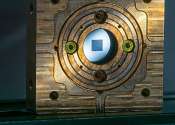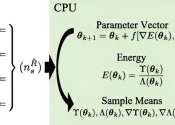In quantum physics, a quantum state is a mathematical object that fully describes a quantum system. One typically imagines some experimental apparatus and procedure which "prepares" this quantum state; the mathematical object then reflects the setup of the apparatus. Quantum states can be statistically mixed, corresponding to an experiment involving a random change of the parameters. States obtained in this way are called mixed states, as opposed to pure states, which cannot be described as a mixture of others. When performing a certain measurement on a quantum state, the result generally described by a probability distribution, and the form that this distribution takes is completely determined by the quantum state and the observable describing the measurement. However, unlike in classical mechanics, the result of a measurement on even a pure quantum state is only determined probabilistically. This reflects a core difference between classical and quantum physics.
Mathematically, a pure quantum state is typically represented by a vector in a Hilbert space. In physics, bra-ket notation is often used to denote such vectors. Linear combinations (superpositions) of vectors can describe interference phenomena. Mixed quantum states are described by density matrices.
In a more general mathematical context, quantum states can be understood as positive normalized linear functionals on a C* algebra; see GNS construction.









